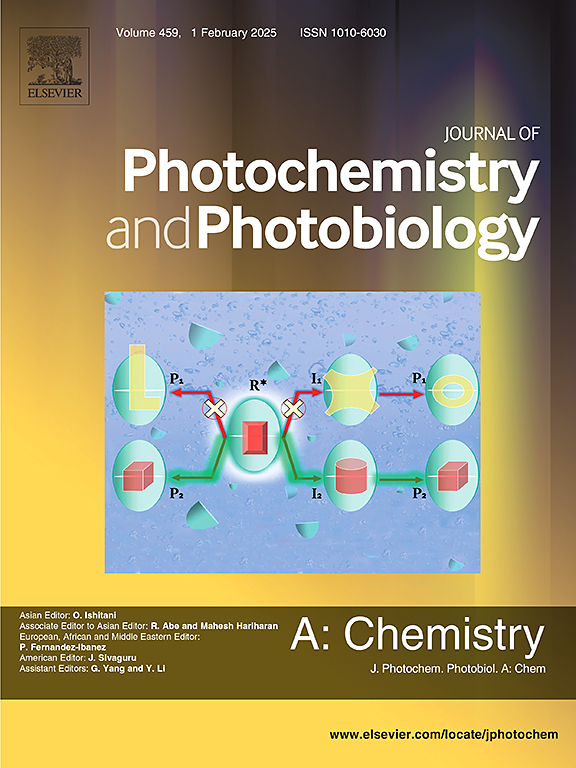Boosted photocatalytic NO conversion with inhibited NO2 generation over Nb2O5/g-C3N4 S-scheme heterojunction: nanostructured engineering and mechanism insight
IF 4.1
3区 化学
Q2 CHEMISTRY, PHYSICAL
Journal of Photochemistry and Photobiology A-chemistry
Pub Date : 2025-06-05
DOI:10.1016/j.jphotochem.2025.116545
引用次数: 0
Abstract
The critical challenge in the photocatalytic treatment of low-concentration nitrogen oxides (NOx) is to achieve deep oxidation of NO while suppressing the formation of toxic intermediate NO2. Herein, a Nb2O5/g-C3N4 S-scheme heterojunction is designed to address this challenge through tailored charge dynamics. Experimental results and theoretical calculations synergistically validate the S-scheme heterojunction featuring an interfacial electric field (IEF)-driven directional charge separation mechanism. This configuration synergistically enhances charge separation efficiency while maintaining robust redox potentials, thereby effectively activating hydroxyl radicals (![]() OH). As the dominant reactive species,
OH). As the dominant reactive species, ![]() OH facilitates deep oxidation of NO while effectively inhibiting toxic NO2 by-product formation. At an initial NO concentration of 800 ppb, the Nb2O5/g-C3N4 S-scheme heterojunction achieved an excellent removal rate of 68.3 % with suppressed NO2 byproduct generation (24.6 ppb) under visible light irradiation (λ ≥ 420 nm) within 20 min. Furthermore, the reaction intermediates were monitored by in-situ diffused reflection Fourier transform infrared spectroscopy (DRIFTS), identifying nitrate as the terminal oxidation product. This work advances the rational design of S-scheme photocatalysts and offers a viable strategy for environmental remediation of NOx contaminants under visible-light-driven conditions.
OH facilitates deep oxidation of NO while effectively inhibiting toxic NO2 by-product formation. At an initial NO concentration of 800 ppb, the Nb2O5/g-C3N4 S-scheme heterojunction achieved an excellent removal rate of 68.3 % with suppressed NO2 byproduct generation (24.6 ppb) under visible light irradiation (λ ≥ 420 nm) within 20 min. Furthermore, the reaction intermediates were monitored by in-situ diffused reflection Fourier transform infrared spectroscopy (DRIFTS), identifying nitrate as the terminal oxidation product. This work advances the rational design of S-scheme photocatalysts and offers a viable strategy for environmental remediation of NOx contaminants under visible-light-driven conditions.

Nb2O5/g-C3N4 S-scheme异质结促进光催化NO转化,抑制NO2生成:纳米结构工程和机制洞察
光催化处理低浓度氮氧化物(NOx)的关键挑战是在实现NO深度氧化的同时抑制有毒中间体NO2的形成。本文设计了一种Nb2O5/g-C3N4 S-scheme异质结,通过定制电荷动力学来解决这一挑战。实验结果和理论计算协同验证了s型异质结具有界面电场驱动的定向电荷分离机制。这种结构协同提高电荷分离效率,同时保持强大的氧化还原电位,从而有效地激活羟基自由基(OH)。OH作为优势反应物质,促进NO的深度氧化,同时有效抑制有毒副产物NO2的生成。在初始NO浓度为800 ppb时,Nb2O5/g-C3N4 S-scheme异质结在可见光(λ≥420 nm)照射下,在20 min内获得了68.3%的良好去除率,抑制了NO2副产物(24.6 ppb)的产生。此外,通过原位漫反射傅里叶变换红外光谱(DRIFTS)监测了反应中间体,确定硝酸盐为最终氧化产物。本研究促进了s型光催化剂的合理设计,为可见光驱动条件下NOx污染物的环境修复提供了可行的策略。
本文章由计算机程序翻译,如有差异,请以英文原文为准。
求助全文
约1分钟内获得全文
求助全文
来源期刊
CiteScore
7.90
自引率
7.00%
发文量
580
审稿时长
48 days
期刊介绍:
JPPA publishes the results of fundamental studies on all aspects of chemical phenomena induced by interactions between light and molecules/matter of all kinds.
All systems capable of being described at the molecular or integrated multimolecular level are appropriate for the journal. This includes all molecular chemical species as well as biomolecular, supramolecular, polymer and other macromolecular systems, as well as solid state photochemistry. In addition, the journal publishes studies of semiconductor and other photoactive organic and inorganic materials, photocatalysis (organic, inorganic, supramolecular and superconductor).
The scope includes condensed and gas phase photochemistry, as well as synchrotron radiation chemistry. A broad range of processes and techniques in photochemistry are covered such as light induced energy, electron and proton transfer; nonlinear photochemical behavior; mechanistic investigation of photochemical reactions and identification of the products of photochemical reactions; quantum yield determinations and measurements of rate constants for primary and secondary photochemical processes; steady-state and time-resolved emission, ultrafast spectroscopic methods, single molecule spectroscopy, time resolved X-ray diffraction, luminescence microscopy, and scattering spectroscopy applied to photochemistry. Papers in emerging and applied areas such as luminescent sensors, electroluminescence, solar energy conversion, atmospheric photochemistry, environmental remediation, and related photocatalytic chemistry are also welcome.

 求助内容:
求助内容: 应助结果提醒方式:
应助结果提醒方式:


